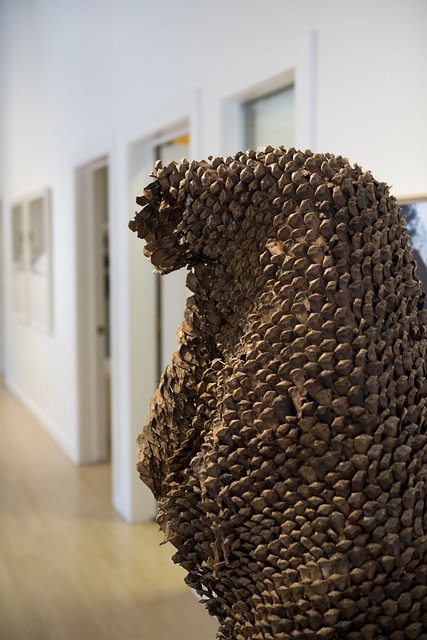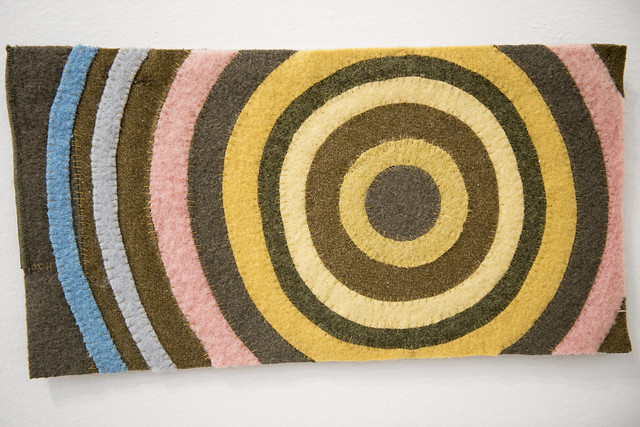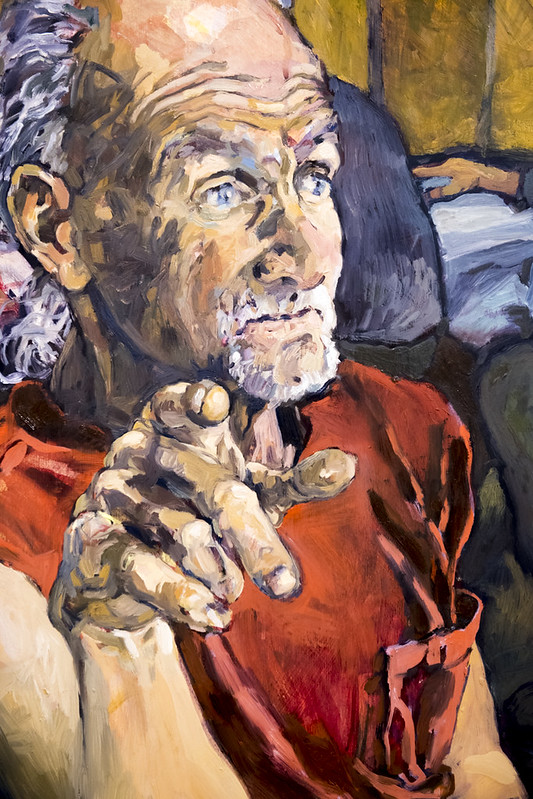Exhibitions in Ketchum
The Bottomlessness of a Pond:
Transcendentalism, Nature and Spirit
January 17–March 11, 2020
A BIG IDEA project of the Sun Valley Center for the Arts
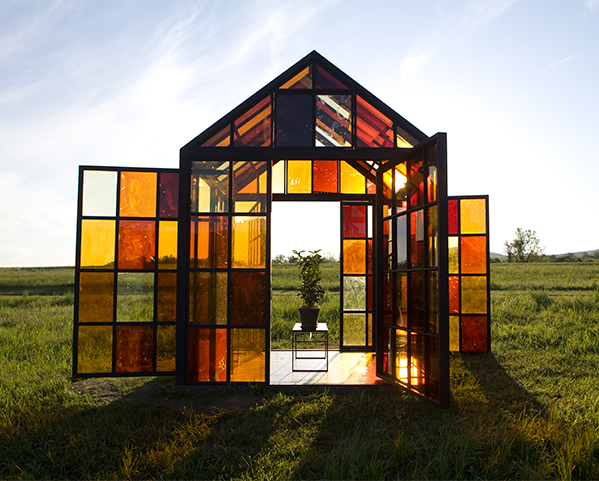
The mid-19th century in the United States saw the emergence of Transcendentalism, a movement of progressive thinkers who advocated for a new understanding of the relationship between the individual, the divine and the natural world. Ralph Waldo Emerson, Henry David Thoreau and Margaret Fuller, among others, came together in a shared belief in a variety of humanitarian causes (women’s suffrage, abolition, progressive education) but also religious purpose. Transcendentalism advocated for a personal knowledge of God based in a rejection of materialism in favor of a spiritual experience of nature. The movement was centered in Concord, Massachusetts, where Thoreau famously spent a year living in a small, spare cabin on Walden Pond, focusing on the spiritual rewards of a life lived in harmony with nature.
This BIG IDEA project asks what lessons Transcendentalism offers us today. It proposes the notion that Transcendentalism’s retreat from the material in favor of a spiritual or divine encounter with nature is an idea that continues to resonate.
VISUAL ARTS
The exhibition includes work by six contemporary artists responding to Trancendentalism and its legacy.
Richard Barnes has made a series of photographs of the Montana cabin once inhabited by Ted Kaczynski (the Unabomber), now kept in an FBI storage locker. Four present the cabin floating against a black background, like evidence. Kaczynski’s cabin, modeled on Thoreau’s, offers an extreme interpretation of Transcendentalist ideas.
Sculptures and collages by Lesley Dill include fragments of text from the poetry of Emily Dickinson and writings of Nathaniel Hawthorne, both affiliated with Transcendentalism while never fully embracing it.
Spencer Finch made the sculpture Walden (surface/depth) after learning about Thoreau’s 1846 survey of Walden Pond. Finch performed that survey again, creating a sculptural record of his project that consists of the 120-foot-long rope he used for his Survey along with watercolor swatches he made at each sounding.
In 2014, the deCordova Museum commissioned William Lamson to make the film In the Roaring Garden, which he filmed using a floating camera obscura inside a 1:5 scale model of Thoreau’s cabin. The exhibition also includes photographs of Lamson’s Solarium, a structure similar to Thoreau’s cabin.
Jane Marsching made the prints in Ice Out at Walden in response to Thoreau’s notation of the day the winter ice cover disappeared at Walden Pond each year. Marsching’s prints use marks to pair Thoreau’s notes in his 1847 weather almanac with measurements collected from a contemporary Concord weather station.
Claire Sherman is known for large-scale paintings that envelop viewers in the natural world, placing them in tangles of dense tree branches or vines. Her dynamic and richly painted images celebrate nature as a place to escape the material world.
VISUAL ARTS EVENTS:
EVENING EXHIBITION TOURS
Thu, Feb 13, and Thu, Mar 5, 5:30pm
FREE at The Museum, Ketchum
Enjoy a glass of wine as you tour the exhibition with The Museum’s curators.
GALLERY WALK
Fri, Feb 14, 5–7pm
FREE at The Museum, Ketchum
ASSOCIATED EVENTS:
FILM: The World Before Your Feet…..Thu, Jan 16, 4:30pm and 7pm
SPECIAL EVENT: A Winter Walk with Matt Green…..Sat, Jan 18, 10am
CREATIVE JUMP-IN: On Being Thoreau with Tim Price….Wed, Jan 22, 29, Feb 5 & 12, 6–7:30pm
CREATIVE JUMP-IN: Diving Deep Into Winter Blues: Healing Through Nature with Cal Millar…..Thu, Jan 23, 6–8:30pm
COMPANY OF FOOLS PLAY READING: The Night Thoreau Spent in Jail by Jerome Lawrence and Robert E. Lee…..Thu, Jan 23, 7pm
TEEN WORKSHOP: Landscape Photography with Sophia DeWolfe…..Sat, Jan 25, 9am–12pm
FREE FAMILY DAY: Nature Play…..Sat, Jan 25, 11am–4pm
PERFORMING ARTS: Taimane “Elemental Tour“…..Sun, Jan 26, 7:30pm
(SOLD OUT!) LECTURE: An Evening with Cheryl Strayed…..Thu, Jan 30, 6:30pm
COMPANY OF FOOLS PLAY READING: Tiny Beautiful Things by Cheryl Strayed…..Sat, Feb 1, 7pm, and Sun, Feb 2, 3pm
CREATIVE JUMP-IN: Finding the Transcendental in Still Life Painting with Sarah Bird…..Mon–Fri, Feb 10–14, 9am–1pm
FILM: Five Season: The Gardens of Piet Oudolf…..Thu, Mar 5, 4:30 and 7pm
CREATIVE JUMP-IN: Self-Care Workshop: Green Studio with Jordyn Dooley…..Sat, Mar 7, 10am–2pm
Behind the Sagebrush Curtain:
Women Modernists in Montana and Idaho
November 15, 2019–January 10, 2020
A Visual Arts Exhibition of the Sun Valley Center for the Arts
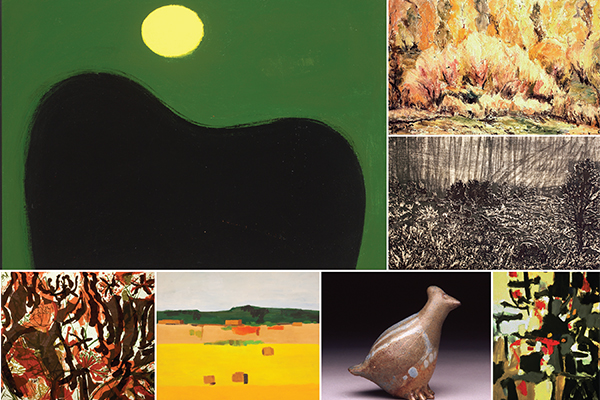
Behind the Sagebrush Curtain includes prints, drawings, paintings and ceramics by seven artists who were active in Montana and Idaho in the second half of the 20th century: Gennie DeWeese, Edith Freeman, Isabelle Johnson, Sara Joyce, Helen McAuslan, Frances Senska and Jessie Wilber. Working in a range of materials and styles, these artists were unified in their desire to marry the landscapes and subject matter of the American West with ideas and techniques that reflected their engagement with international modernism. Many of these women also served as teachers and mentors throughout their careers, influencing the work of younger artists in the Intermountain West for decades.
The exhibition takes its title from a recent interview with Donna Forbes, longtime Executive Director of the Yellowstone Art Museum and a personal friend of the artist Isabelle Johnson. In the interview, which can be found on the website for Tippet Rise Art Center in Montana, Ms. Forbes discusses Montana’s art scene in the 1950s and 1960s. She describes her colleagues as feeling cut off from the major centers of the art world and remembers a friend commenting that in Montana, artists were stuck “behind the sagebrush curtain.”
But as the exhibition illustrates, artists in the West, despite their relative isolation, were actively working with modernist ideas. For some of the women in the exhibition, artistic training in the East provided an introduction to the visual language of modernism. Bringing that training west, these artists translated that language into something uniquely of this place. The exhibition focuses on women artists whose work has been less widely exhibited than that of their male counterparts—women who were, in essence, working behind a second curtain.
EXHIBITION VIDEO
PHOTO GALLERY
VISUAL ARTS EVENTS:
Evening Exhibition Tours
Thu, Nov 21, Thu, Dec 12 and Thu, Jan 9*, 5:30pm
FREE at The Center, Ketchum
Enjoy a glass of wine as you tour the exhibition with The Center’s curators.
*On Jan 9, members of Sara Joyce’s family will join us to discuss her work.
Gallery Walks
Fri, Nov 29, 4-6pm (special Giving Walk hours)
Fri, Dec 27, 5-7pm
FREE at The Center, Ketchum
Marketplaces: From Open Air to Online
August 30–November 8, 2019
A BIG IDEA project of the Sun Valley Center for the Arts

This BIG IDEA considers the idea of the marketplace in the 21st century. How has our exchange of goods and services changed? What remains the same? How do our choices as consumers shape our society?
Over the last 25 years, there has been a radical transformation in the way Americans buy and sell goods and services. Motivated by the perception of convenience, we are increasingly choosing to shop online from the comfort of our own homes or in big-box stores where we believe “one-stop shopping” will save us time and money. As a result, small, independently owned stores face serious challenges, leaving vacant storefronts along our Main Streets. Even many chain stores have struggled, and giant malls, which were once hubs of social activity as well as commerce, lie empty.
These recent shifts are part of our continually evolving relationship with the idea of the marketplace—a commercial space that has taken myriad forms over human history, from open-air markets and ancient trade routes that linked far-flung parts of the globe to small shops owned by specialty retailers, enormous big-box stores, and the online sites that comprise much of today’s retail market. And how do we buy and sell pieces of the companies that provide those goods? The health of the stock market affects everyone—even those who don’t own stock.
While big-box stores and online shop-ping may be big business, there has also been a simultaneous resurgence in farmers markets, a call to shop locally, and reinvestment in the downtowns of small towns and cities across the U.S. This BIG IDEA projects sheds light on the complex intersections of these marketplaces and how our choices as consumers shape our society.
CLICK HERE to view the exhibition brochure.
PHOTO GALLERY
EXHIBITION VIDEO
MUSEUM EXHIBITION
The Sun Valley Center for the Arts invited artist Conrad Bakker to participate in a residency at The Center, Hailey, and respond to the economies of the Wood River Valley. Drawn to the area’s history as a place for mining as well as mountain recreation, Bakker collected nearly 100 Idaho rocks that he then recreated as small sculptures. Each rock will be oICK fered for sale as part of a larger installation, Untitled Project: Mountain Rock Shop. Visitors are invited to purchase a rock that they’ll be able to collect at the conclusion of the exhibition. Bakker’s Mountain Rock Shop also exists as an online marketplace: www.untitledprojects.com/mountainrockshop.
Chad Erpelding marries data visualization and geometric abstraction in paintings that investigate global institutions. Marketplaces includes work from two projects that use color and pattern to represent trends in stock indices. One explores the impact of the 2016 vote in favor of Brexit on financial markets around the world. The other looks at the value of the major U.S. stock indices, from the low point of the 2008 recession to the high point of the economic recovery. Erpelding’s projects consider the way we buy and sell pieces of corporations, the interconnectedness of global economies, and the effects of political and social events on the economic lives of individuals.
Through most of the 1990s, American painter Brendan O’Connell lived and worked in Europe. Upon his return to the U.S., he was struck by how significantly American society had changed—particularly the way Ameri-cans now shopped. Walmart had dramatically expanded its chain of stores, fundamentally altering Americans’ relationship with retail. O’Connell began visiting Walmart stores across the country, capturing the architecture, shop-pers and brands he encountered along the way and creating a portrait of American consumption in the 21st century.
Brittany Powell Parich’s project Checkout includes approximately life-size sculptures of every item in one checkout lane of her local Fred Meyer store on one day in the summer of 2018. The sculptures’ bright colors and eye-catching logos are testament to the temptations of the grocery store checkout line, where carefully arranged displays of everything from candy and cough drops to beef jerky and Bic lighters beckon to shoppers. Powell Parich’s Checkout even includes summer 2018 issues of popular magazines like People and Better Homes & Gardens, a kind of grocery store time capsule.
The works in Mark R. Smith’s project The Silk Road investigate the history of commerce and trade along the historic Silk Road, which linked Asia to the Mediterranean, and on the online black market of the same name, which was a notorious site for the sale of illicit goods from 2011 to 2013. Smith’s large geometric works recall both textile patterns and computer circuitry. Smaller works feature images of real items he found for sale on the Silk Road website, from antiquities to construction equipment and drug paraphernalia. Smith invites viewers to consider the ways commerce has changed over time, from open-air bazaars to online market-places, but his project also underlines the fact that goods and services have circulated across vast geographical areas for centuries.
VISUAL ARTS EVENTS:
Opening Celebration & Gallery Walk
Fri, Aug 30, 5–7pm
FREE at The Center, Ketchum
Join us as we celebrate the opening of Marketplaces. Artists Chad Erpelding and Mark R. Smith will speak about their work at 6pm.
Evening Exhibition Tours
Thu, Sep 19 & Thu, Oct 24, 5:30pm
FREE at The Center, Ketchum
Enjoy a glass of wine as you tour the exhibition with The Center’s curators.
ASSOCIATED EVENTS:
- FAMILY DAY: Buy, Buy, Buy…..Sat, Sep 28, 11am–4pm
- FEATURED SPEAKER: Kirk Wallace Johnson: “The Feather Thief”…..Thu, Sep 12, 6:30pm
- PANEL DISCUSSION: Mighty Main Street Revival —Twin Falls, ID, and Tieton, WA…..Tue, Sep 17, 6pm
- PANEL DISCUSSION: From Rural to Global in Sun Valley…..Tue, Oct 15, 6pm
- FILM SCREENING: Carmine Street Guitars…..Thu, Sep 19, 4:30 and 7pm
- FILM SCREENING: Spettacolo…..Thu, Oct 24, 4:30 and 7pm
- FILM SCREENING: The Biggest Little Farm…..Thu, Nov 14, 4:30 & 7pm
Mirage: Energy, Water and Creativity in the Great Basin
Jun 12 – Aug 23, 2019
A Visual Arts Exhibition of the Sun Valley Center for the Arts
 The Great Basin is a vast expanse of land covering much of the American West, with its rivers draining internally rather than to the ocean. Its boundaries circumscribe parts of Oregon, Idaho, Utah, Wyoming and California, and nearly all of Nevada. The Mirage exhibition uses the idea of a closed watershed system as a metaphor for thinking about this uniquely dynamic landscape as a source of regenerative power: a place of resource extraction and renewable energy, a place that has long generated creativity (including Land Art works), and a place of shifting boundaries. The Great Basin is also a place of contradictions. Much of it is desert, but it comprises multiple ecosystems and topographies; this incongruity mirrors the fact that though the region is now largely arid, it was once an inland sea. Despite the fact that it holds vast stretches of open, unoccupied land, it is a place of mystery and obscurity. Its scale allows individuals, corporations and government agencies to do things they can’t do elsewhere, from creating monumental artworks on the land to extracting natural resources or installing enormous wind farms, from testing weapons to experimenting with technology.
The Great Basin is a vast expanse of land covering much of the American West, with its rivers draining internally rather than to the ocean. Its boundaries circumscribe parts of Oregon, Idaho, Utah, Wyoming and California, and nearly all of Nevada. The Mirage exhibition uses the idea of a closed watershed system as a metaphor for thinking about this uniquely dynamic landscape as a source of regenerative power: a place of resource extraction and renewable energy, a place that has long generated creativity (including Land Art works), and a place of shifting boundaries. The Great Basin is also a place of contradictions. Much of it is desert, but it comprises multiple ecosystems and topographies; this incongruity mirrors the fact that though the region is now largely arid, it was once an inland sea. Despite the fact that it holds vast stretches of open, unoccupied land, it is a place of mystery and obscurity. Its scale allows individuals, corporations and government agencies to do things they can’t do elsewhere, from creating monumental artworks on the land to extracting natural resources or installing enormous wind farms, from testing weapons to experimenting with technology.
Artists have long been inspired by the many paradoxes of the region. Each participating artist in the Mirage exhibition presents work that considers the Great Basin from a different point of view:
Inspired in part by her great-grandmother’s work as an itinerant schoolteacher in Nevada’s mining towns, the photographs in Laura McPhee’s project “Desert Chronicle” approach the history of the Great Basin on both geologic and human scale. From images of the detritus left behind in abandoned towns to photographs of the infrastructure of contemporary gold mines and wind farms, McPhee’s work considers the human relationship to the landscape of the Great Basin as a place of reinvention, exploitation and renewal.
The artist Fazal Sheikh has collaborated with writer Terry Tempest Williams on “Exposure,” which emerged in response to the recent decision to significantly reduce two National Monuments in Utah. One of these is Grand Staircase-Escalante, currently defined by the Great Basin’s boundary on its northern edge, a natural definition it may lose in order to enable resource extraction.
Photographer Emmet Gowin has made aerial photographs throughout the western U.S. that illuminate the human impact on the landscape. One body of photographs records the scarred and cratered landscapes of the Nevada Test Site, the site of more than 900 nuclear tests over more than four decades. Other images reveal the long-term effects of mining and other human activities on the surface of the Great Basin’s landscapes.
The exhibition also includes new work by painter Cedra Wood. The Center commissioned Wood to travel throughout the Great Basin and respond to it through her work, which investigates ecological concepts of belonging and survival through hyper-realistic imagery that often incorporates fantasy. Wood found inspiration for her new works at sites that reveal the extremes in topography and environment within the Great Basin.
Painter/printmaker Frances Ashforth contributes new work about the Great Basin watershed that draws on her deep interest in the human relationship to water. Her abstracted landscape images have a lyrical beauty that reflects her conservationist impulses. The exhibition contains monotypes made at two distinct sites in the Great Basin — the Ana River/Summer Lake area of Oregon and Bear River/Antelope Island in Utah.
Other work in the exhibition considers the Great Basin as a site of creative energy — a place where artists have been inspired and able to pursue projects they couldn’t realize elsewhere. Andrea Zittel was one of the founders of High Desert Test Sites near Joshua Tree, California, a place for artistic and cultural experimentation that has hosted projects by numerous artists. For Zittel, the southwestern corner of the Great Basin that is home to High Desert Test Sites has long been a source of artistic inspiration. The exhibition includes a large-scale painting by Zittel paired with one of her “Wall Sprawl” works — wallpaper generated from aerial photographs of urban, industrial and military development in the Great Basin’s deserts.
For Land Artists working in the 1970s, the Great Basin offered the opportunity to execute large-scale projects in remote landscapes relatively untouched by development. Vast open spaces and inexpensive real estate allowed Nancy Holt and Robert Smithson to create works outside (and far from) the traditional institutional structures of the art world. The exhibition includes Holt’s film “Sun Tunnels” and Smithson’s “Spiral Jetty,” both made during their work on their earthworks of the same name. Alongside these works are a series of related exhibition prints.
Click here to view the Exhibition Brochure.
Click here to view the Exhibition Catalog.
EXHIBITION VIDEO:
PHOTO GALLERY:
ASSOCIATED EVENTS:
FREE Gallery Exhibition…..June 12–Aug. 23, 2019
FREE Opening Celebration…..Thursday, June 13, 5 p.m.
FREE Panel Discussion: “Is Landscape Still Relevant in 21st-Century Art?”…..Thursday, June 13, 6 p.m.
FREE Evening Exhibition Tour…..Thursday, June 27, 5:30 p.m.
FREE Gallery Walk…..Friday, July 5, 5–7 p.m.
FREE Panel Discussion: “Photographing the Great Basin”…..Tuesday, July 9, 6 p.m.
FREE Gallery Walk…..Friday, Aug. 2, 5–7 p.m.
FREE Evening Exhibition Tour…..Thursday, Aug. 15, 5:30 p.m.
In addition, the Mirage exhibition includes family visitor guides for younger patrons and hands-on activities for learners of all ages in The Center’s maker space.
 Mirage: Energy, Water and Creativity in the Great Basin is supported in part by grants from the Robert Lehman Foundation and an award from the National Endowment for the Arts. The Center applied for NEA funding through Art Works, the Arts Endowment’s principal grantmaking program. After convening panels to review 1,605 eligible grant applications, the agency awarded 972 grants, one of which will help underwrite Mirage.
Mirage: Energy, Water and Creativity in the Great Basin is supported in part by grants from the Robert Lehman Foundation and an award from the National Endowment for the Arts. The Center applied for NEA funding through Art Works, the Arts Endowment’s principal grantmaking program. After convening panels to review 1,605 eligible grant applications, the agency awarded 972 grants, one of which will help underwrite Mirage.
Following its exhibition at the Sun Valley Center for the Arts, Mirage: Energy, Water and Creativity in the Great Basin will travel to the Boise Art Museum in 2020.
Unraveling: Reimagining Colonization in the Americas
March 8–May 22, 2019
A BIG IDEA Project of the Sun Valley Center for the Arts
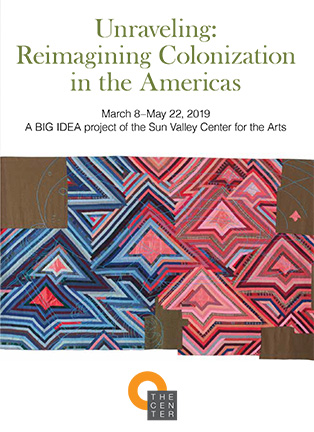 In American textbooks, the colonial history of the Americas is often presented as a straightforward story of European conquest of indigenous cultures. It is a story of settlement and expansion by the Spanish, Portuguese, English, Dutch and French as these European powers competed for possession of American territory—lands already occupied for millennia by native peoples. The real story, however, is anything but straight-forward. This history is fraught with conflict and negotiation, wars and treaties, sales and transfers of enormous swaths of land, usually without input from the original occupants. Even today the theme of Manifest Destiny runs through this version of history, obscuring the stories of those who were dispossessed by the colonial process.
In American textbooks, the colonial history of the Americas is often presented as a straightforward story of European conquest of indigenous cultures. It is a story of settlement and expansion by the Spanish, Portuguese, English, Dutch and French as these European powers competed for possession of American territory—lands already occupied for millennia by native peoples. The real story, however, is anything but straight-forward. This history is fraught with conflict and negotiation, wars and treaties, sales and transfers of enormous swaths of land, usually without input from the original occupants. Even today the theme of Manifest Destiny runs through this version of history, obscuring the stories of those who were dispossessed by the colonial process.
What does this history omit? What are the possibilities for reimagining or reinterpreting colonial history from the indigenous point of view?
This BIG IDEA project offers an opportunity for retelling the colonial history of the Americas, offering up alternative perspectives and stories based on both fact and fiction.
Click here to view the Exhibition Brochure
Exhibition Photo Gallery
Exhibition Video
Interview with Gay Bawa Odmark
A personal history of Gay Bawa Odmark’s experience of the 1947 Partion of India. Interviewed by Dr. Courtney Gilbert of the Sun Valley Center for the Arts at Community Library, Ketchum, ID. March 2019
MUSEUM EXHIBITION
Nicholas Galanin (Tlingit/Aleut) creates work that considers the intersection of native and non-native cultures in the U.S. The exhibition features an installation of two video pieces that invite viewers to reimagine colonization not as a one-way process, but as a dynamic system of cultural exchange. The installation also includes monoprints from the series Let Them Enter Dancing.
Several years ago, Marcos Ramírez ERRE and David Taylor resurveyed the U.S.-Mexico border as it existed in 1821. Running from the Gulf of Mexico to what is now the demarcation between Oregon and California, the border shifted radically; enormous areas of what had been Mexico were ceded to the U.S. Along their journey, Ramírez ERRE and Taylor placed obelisks similar to those that mark the miles of the current border and photographed them in the sites they would have occupied in 1821. The resulting installation, DeLIMITations, features one of these monuments, a video work and 48 photographs of monuments sited along their route.
Umar Rashid (also known as Frohawk Two Feathers) has created paintings and works on paper that reimagine the history of colonization in the Americas. His elaborate and often funny narratives, which feature invented nations and recurring characters, offer viewers alternative visions of the struggle for land and power on American soil. For this exhibition, Rashid has created new works that illustrate his own imagined history of clashes and cultural collisions between native peoples and European colonizers in the American West.
The work of Marie Watt (an enrolled member of the Seneca Nation of Indians) draws on ideas from history, indigenous principles, feminism and her desire to use her practice to build community. Many of her projects incorporate the woolen blanket. For Watt, blankets are loaded with history and symbolism, used as a ritual objects, given as gifts, or used to cover and protect.
The Sun Valley Center for the Arts would like to acknowledge the Shoshoni and Bannock People and their Homelands here in the Wood River Valley, and their use of these lands, Past, Present and Future.
VISUAL ARTS EVENTS
Museum Exhibition
March 8–May 22, 2019
FREE at The Center, Ketchum
Mon-Fri, 9am-5pm, Sats in March, 11am-5pm
Exhibition Opening Celebration & Gallery Walk
Fri, Mar 8, 5–7pm
FREE at The Center, Ketchum
Join us as we celebrate the opening of Unraveling: Reimagining Colonization in the Americas
Evening Exhibition Tours
Thu, Mar 21, Thu, Apr 18, and Thu, May 16* 5:30pm
FREE at The Center, Ketchum
Enjoy a glass of wine as you tour the exhibition with The Center’s curators.
*May 16 tour will begin at The Center before heading to the Community Library’s Regional History Museum for a tour of their exhibition: Who Writes History? Frontier Voices, Native Realities an examination of the co-existence between Native Americans and non-native newcomers to the Wood River Valley in the late 19th and early 20th centuries. Regional History Museum, Mar 8–Jun 29.
ASSOCIATED EVENTS
FAMILY DAY: How I Remember It: A Chance to Consider Another PerspectiveSat, Apr 13, 3–5pm
FREE at The Center, Ketchum
Geared for children 3–12 years old.
Come enjoy a free, fun, friendly and activity-packed afternoon at The Center with your children, grandchildren or family members! We will spend the afternoon offering up alternative perspectives to stories based on both fact and fiction, and we’ll consider how one’s own perspective may affect how a story is told. Join us anytime between 3 and 5pm.
- Participate in story time at 3:30 or 4:30
- Create a clay medallion that represents your personal journey
- Play games and participate in activities that connect to the art in the museum
- Share a treat and a story with your family
Generously sponsored by Spur Community Foundation.
TEEN WORKSHOP: Imagining New Landscapes: Watercolor Workshop with Jennie Kilcup
Sat & Sun, Apr 13 & 14, 10am–3pm
The Center, Hailey
$10 pre-registration required
This workshop is geared toward teens who have little or no watercolor experience. Students will learn the elements necessary to master several watercolor techniques. They will then incorporate these techniques into vibrant finished pieces ready for framing! Students will take home a complete watercolor kit to continue practicing the techniques taught in the class.
Generously sponsored by Joyce B. Friedman in memory of Norman Friedman.
LECTURE: David Grann “The Killers of the Flower Moon: The Arc of Justice”
Thu, Mar 14, 6:30pm
Church of the Big Wood, Ketchum
$20 / $30 nonmembers
$15 students / educator (limit one per educator) David Grann is a writer for
The New Yorker and the best-selling author of The Lost City of Z and Killers of the Flower Moon. Grann’s latest book, Killers of the Flower Moon: The Osage Murders and the Birth of the FBI, is a true crime tale that unravels one of the most sinister crimes and racial injustices in American history. With more than 30 weeks on The New York Times nonfiction best-seller list, it was a finalist for the National Book Award. Known for his compelling and irresistible stories, Grann has been called “the man Hollywood can’t stop reading,” with four of his New Yorker articles adapted for the screen.
Generously sponsored by an anonymous gift and American Capital Advisory.
LECTURE: The Consequences of Colonialism: A Conversation with Gay Bawa Odmark on the 1947 Partition of India
Tue, Mar 19, 6pm
FREE at The Community Library
Join The Center’s Curator of Visual Arts, Courtney Gilbert, for a conversation with Gay Bawa Odmark about the aftermath of colonial-ism in another part of the globe—India. Born in the city of Lahore (in what is now Pakistan), Odmark lived through India’s 1947 Partition (into India and Pakistan), experiencing firsthand the upheaval that followed British withdrawal from the region after nearly a century of British Crown rule. Odmark will share memories of her childhood in Lahore, the violence of Partition, and her family’s experiences fleeing Lahore for England before settling in Kolkata. The talk will include photo-graphs from Odmark’s family albums as well as images of artwork she has made in response to her memories of life in India.
ART HISTORY LECTURE: “The World Turned Upside Down: Felipe Guaman Poma de Ayala’s The First New Chronicle and Good Government” with Dr. Courtney Gilbert
Tue, Apr 16, 5:30pm
The Center, Ketchum
$10 / $12 nonmember
At the beginning of the 17th century, an indigenous Andean man, don Felipe Guaman Poma de Ayala, wrote a nearly 1,200-page letter to King Philip III of Spain. The letter gave the king a history of Andean culture and traditions before the Spanish conquest. Guaman Poma outlined the conquest and the effects of Spanish colonial rule on the Andean world, which he believed had been turned upside down by Spanish administrators. The letter then proposed a new form of government that would incorporate pre-conquest Andean practices. In addition to his written text, Guaman Poma included 398 full-page line drawings. This lecture focuses on these fascinating drawings, which provide a glimpse into life in the Viceroyalty of Peru.
At the Table: Kitchen as Home
December 21, 2018–March 1, 2019
A BIG IDEA Project of the Sun Valley Center for the Arts
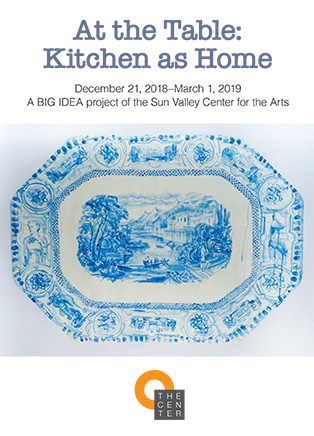 For many of us, the kitchen plays a part in our earliest memories—memories that are multi-sensual, bringing taste and smell together with our visual recollections of the spaces in which our families gathered. We often recreate our childhood memories of the kitchen as adults, cooking from recipes our parents used, buying the same foods that lined our childhood shelves, or serving meals on dishes inherited from grandparents. The BIG IDEA project At the Table: Kitchen as Home considers the central role of the kitchen in shaping our memories, our families and our social lives. Kitchens are spaces of ritual—places for the preparation of food as well as its sharing. We come together in kitchens to cook and to eat, to share in conversation, to do homework, to plant small gardens or make art, to entertain friends and family. Kitchens can be places for culinary creativity and experimentation, but they also offer the security of repetition—the pot of coffee prepared the same way every morning or the meal thrown together by rote. A kitchen’s contents reflect its occupants’ tastes and habits: a peek into someone’s refrigerator, pantry or utensil drawer offers insights into how they live and how they nourish themselves. At their best, kitchens are places of comfort. They offer the opportunity to connect to our past through the making and sharing of food with those we care for in the present.
For many of us, the kitchen plays a part in our earliest memories—memories that are multi-sensual, bringing taste and smell together with our visual recollections of the spaces in which our families gathered. We often recreate our childhood memories of the kitchen as adults, cooking from recipes our parents used, buying the same foods that lined our childhood shelves, or serving meals on dishes inherited from grandparents. The BIG IDEA project At the Table: Kitchen as Home considers the central role of the kitchen in shaping our memories, our families and our social lives. Kitchens are spaces of ritual—places for the preparation of food as well as its sharing. We come together in kitchens to cook and to eat, to share in conversation, to do homework, to plant small gardens or make art, to entertain friends and family. Kitchens can be places for culinary creativity and experimentation, but they also offer the security of repetition—the pot of coffee prepared the same way every morning or the meal thrown together by rote. A kitchen’s contents reflect its occupants’ tastes and habits: a peek into someone’s refrigerator, pantry or utensil drawer offers insights into how they live and how they nourish themselves. At their best, kitchens are places of comfort. They offer the opportunity to connect to our past through the making and sharing of food with those we care for in the present.
The BIG IDEA project At the Table: Kitchen as Home is generously supported by Ali Long.
Click here to view the Exhibition Brochure
Exhibition Video
Photo Gallery
MUSEUM EXHIBITION
Abby Carter spent several years volunteering in a soup kitchen in Connecticut. She got to know its patrons and began making portraits of the many different people for whom the soup kitchen was a vital resource. The exhibition includes a selection of her portraits, some offering views of the interior of the soup kitchen as well as its guests.
Illustrator Ferris Cook has made a series of drawings of individual kitchen objects: an espresso maker, a toaster, a spoon. Her elegant pencil drawings depict the cherished tools we turn to when preparing our food. They are paired with an installation of kitchen objects on loan from residents of the Wood River Valley.
Benny Fountain has produced a number of paintings that marry the interior of the kitchen in a house he once owned in Portland, Oregon, with views through a window to the northern Idaho landscapes of his childhood. His paintings underline the connection between kitchens and our memories of place.
Julie Green’s painting practice has long addressed themes of food and the domestic. The Center commissioned Green to spend time in residence at the Sun Valley Center for the Arts, Hailey, making work in response to the history of the house. In Hailey, Green produced several large paintings on Tyvek inspired by plates and platters she encountered in the house as well as the life of one of its most prominent occupants, Roberta McKercher. The exhibition pairs these new works with Green’s An Embarrassment of Dishes, a Noritake dinner service for 12 inherited from her grandmother that she painted and inscribed with stories from her youth.
MK Guth has produced a number of sculptures that combine books, objects and written instructions for different kinds of events that involve the preparation and sharing of food and drink. The exhibition includes two sculptures, Dinner for Remembering and Dinner to Plan a Revolution. Her works invite viewers to consider the ways that shared meals can be transformative experiences.
Following the birth of her first child, Joan Linder began making daily drawings of her kitchen sink “brimming with dishes, recently washed, or practically untouched.” The drawings capture the accumulation of plates and cups, cleaning supplies and cooking ingredients that result from meals prepared and enjoyed. They convey the passage of time in the kitchen, where labor repeats itself in a daily cycle.
Julie Green’s residency is generously sponsored by Jennifer Wilson.
VISUAL ARTS EVENTS
Museum Exhibition
Dec 21, 2018–March 1, 2019
FREE at The Center, Ketchum
Mon-Fri, 9am-5pm Sats in Feb, 11am-5pm
Evening Exhibition Tour
Thu, Jan 3, 5:30pm
FREE at The Center, Ketchum
Artist Talk: MK Guth
Wed, Jan 9, 5:30pm
FREE at The Center, Ketchum
Join artist MK Guth for an evening talk about the role of social ritual, performance, food and drink within her artistic practice.
Evening Exhibition Tour and Artist Talk with Abby Carter, with special guests from the Hunger Coalition
Thu, Jan 24, 5:30pm FREE at The Center, Ketchum
Artist Abby Carter will discuss her portraits of the guests of a Connecticut soup kitchen. Staff and participants from the Hunger Coalition will join the conversation, sharing images and stories from their Authentic Voices project. Join us for a dialogue about food insecurity in the Wood River Valley and beyond.
Evening Exhibition Tour and Artist Talk with Artist Julie Green
Thu, Feb 7, 5:30pm FREE at The Center, Ketchum
Enjoy a glass of wine as you tour the exhibition with The Center’s curators and museum guides.
Gallery Walk
Fri, Dec 28 & Feb 15, 5–7pm
FREE at The Center, Ketchum
Start your Gallery Walk at The Center!
ASSOCIATED EVENTS
- LECTURE: Cooking Shouldn’t Kill with Nancy Hughes and Taylor Rixon…..Thu, Jan 3, 6:30pm
- FILM: The Irish Pub Thu, Jan 10…..4:30 and 7pm
- FAMILY DAY: Art, drink and be merry!…..Sat, Jan 12, 3–5pm
- CREATIVE JUMP-IN: Sketching Kitchen Memories with Bob Dix…..Wed, Jan 16, 5:30–8pm
- FILM: Chef Flynn, Thu, Jan 24…..4:30 and 7pm
- PERFORMING ARTS: Winter Warm-up Veillée with Bon Débarras…..Thu, Jan 17, 7pm
- TEEN WORKSHOP: Cookie Art! with Virginia McConnell of Canuck Cookies…..Sat, Jan 26, 10am–4pm
- SPECIAL EVENT: Gather Around: Public Storytelling with Idaho Basecamp…..Thu, Jan 31, 6pm
- COMPANY OF FOOLS THEATRE: Dinners with Friends: Recipes for Storytelling A series of short reflections…..Fri, Feb 1, 7pm
- LECTURE: Joanne Weir: “Plates, Places and Stories from My Family Kitchen”…..Sat, Feb 23, 4pm





